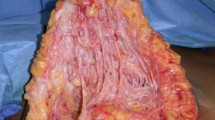Abstract
In 2000, Sound Surgical Technologies LLC of Louisville, Colorado, introduced a third-generation ultrasound device for assisted lipoplasty called Vaser, an acronym for vibration amplification of sound energy at resonance. The Vaser console consists of an integrated system including all the elements required for flow rate-controlled infiltration of tumescent fluid, tissue-selective destruction of fat, negative pressure aspiration, and collection of fat in disposable canisters. The technique is described.
Access this chapter
Tax calculation will be finalised at checkout
Purchases are for personal use only
Similar content being viewed by others
References
The American Society for Aesthetic Plastic Surgery: cosmetic surgery national databank statistics 2009. ASAPS website www.surgery.org (accessed in 2011)
Flynn TC, Coleman WP III, Field LM, Klein JA, Hanke CW (2000) History of liposuction. Dermatol Surg 26(6):515–520
Coldiron BM, Healy C, Bene NI (2008) Office surgery incidents: what seven years of Florida data show us. Dermatol Surg 34(3):285–291
Housman TS, Lawrence N, Mellen BG, George MN, Filippo JS, Cerveny KA, DeMarco M, Feldman SR, Fleischer AB (2002) The safety of liposuction: results of a national survey. Dermatol Surg 28(11):971–978
Coleman WP III, Hanke CW, Lillis P, Bernstein G, Narins R (1999) Does the location of the surgery or the specialty of the physician affect malpractice claims in liposuction? Dermatol Surg 25(5):343–347
Hanke CW, Lee MW, Bernstein G (1990) The safety of dermatologic liposuction surgery. Dermatol Clin 8(3):563–568
Fischer A, Fischer G (1976) First surgical treatment for molding body’s cellulite with three 5 mm incisions. Bull Int Acad Cosm Surg 3:35–37
Klein JA (1987) The tumescent technique for liposuction surgery. Am J Cosm Surg 4:236–267
Grippaudo F, Matarese M, Macone A, Mazzocchi M, Scuderi N (2000) Effects of traditional and ultrasonic liposuction on adipose tissue: a biochemical approach. Plast Reconstr Surg 106(1):197–199
Zocchi ML (1999) Basic physics for ultrasound-assisted lipoplasty. Clin Plast Surg 26(2):209–220
Grolleau JL, Rouge D, Chavoin JP, Costagliola M (1997) Severe cutaneous necrosis after ultrasound lipolysis: medicolegal aspects and review. Ann Chir Plast Esthet 42(1):31–36
Fodor PB (2004) Personal experience with ultrasound-assisted lipoplasty: a pilot study comparing ultrasound-assisted lipoplasty with traditional lipoplasty. Plast Reconstr Surg 113(6):1852–1854
De Souza Pinto EB, Abdala PC, Maciel CM, dos Santos F de P, de Souza RP (2006) Liposuction and VASER. Clin Plast Surg 33(1):107–115
Garcia O Jr, Nathan N (2008) Comparative analysis of blood loss in suction-assisted lipoplasty and third-generation internal ultrasound-assisted lipoplasty. Aesthet Surg J 28(4):430–435
Cimino WW (2006) VASER-assisted lipoplasty: technology and technique. In: Shiffman MA, Di Giuseppe A (eds) Liposuction principles and practice. Springer, Berlin, pp 239–244
Prendergast PM (2010) Liposculpture of the abdomen in an office-based practice. In: Shiffman MA, Di Giuseppe A (eds) Body contouring: art, science, and clinical practice. Springer, Berlin, pp 219–237
Ostad A, Kageyama N, Moy RL (1996) Tumescent anesthesia with a lidocaine dose of 55 mg/kg is safe for liposuction. Dermatol Surg 22(11):921–927
Yang CH, Hsu HC, Shen SC, Juan WH, Hong HS, Chen CH (2006) Warm and neutral tumescent anesthetic solutions are essential factors for a less painful injection. Dermatol Surg 32(9):1119–1122
Sattler G, Sattler S (2007) Physiodynamic concept of tumescence. In: Hanke CW, Sattler G, Sommer B (eds) Textbook of liposuction. Informa Healthcare, Boca Raton, Florida, p 43, 5
Jewell ML, Fodor PB, de Souza Pinto EB, Al Shammari MA (2002) Clinical application of VASER-assisted lipoplasty: a pilot clinical study. Aesthet Surg J 22(2):131–146
Master course in VASER liposculpture: European College of Aesthetic Medicine (ECAM). Website www.ecamedicine.com (accessed in 2011)
Author information
Authors and Affiliations
Corresponding author
Editor information
Editors and Affiliations
Rights and permissions
Copyright information
© 2013 Springer-Verlag Berlin Heidelberg
About this chapter
Cite this chapter
Prendergast, P.M. (2013). Ultrasound-Assisted Abdominal Liposuction. In: Shiffman, M., Di Giuseppe, A. (eds) Cosmetic Surgery. Springer, Berlin, Heidelberg. https://doi.org/10.1007/978-3-642-21837-8_55
Download citation
DOI: https://doi.org/10.1007/978-3-642-21837-8_55
Published:
Publisher Name: Springer, Berlin, Heidelberg
Print ISBN: 978-3-642-21836-1
Online ISBN: 978-3-642-21837-8
eBook Packages: MedicineMedicine (R0)




